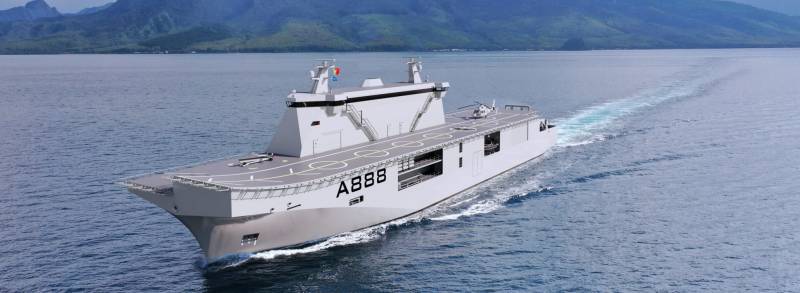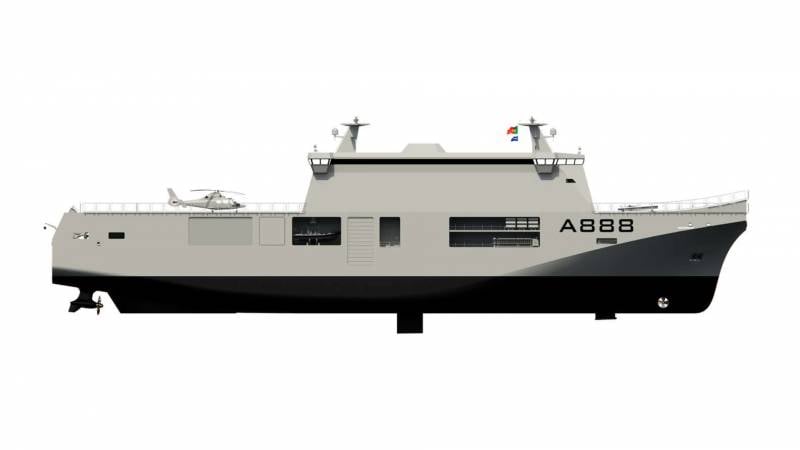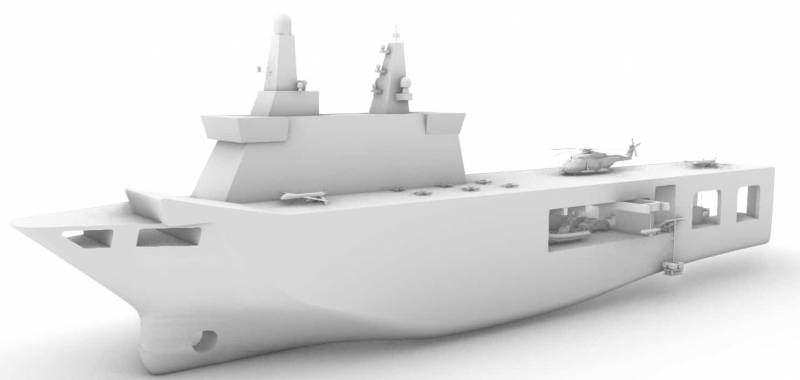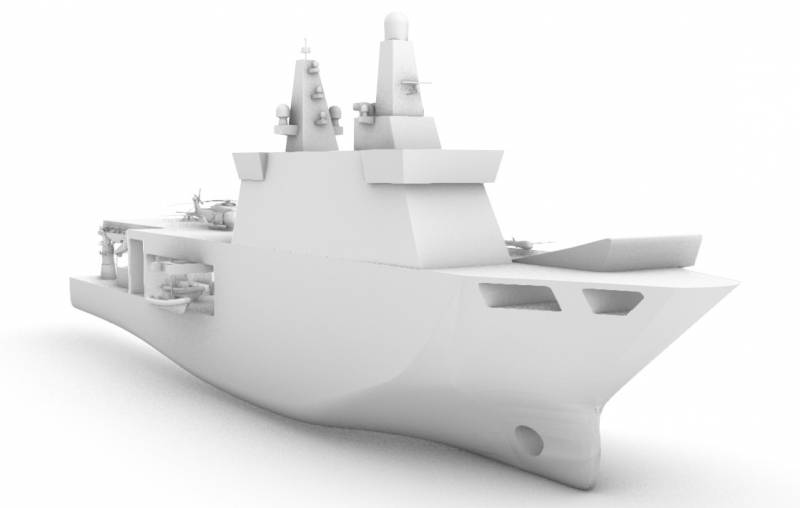The Portuguese Navy has ordered a carrier vessel for unmanned systems

Design appearance of the PNM vessel from Damen Shipyards Group
The Portuguese Navy ordered the development and construction of the promising multifunctional vessel Plataforma Naval Multifuncional. The goal of this project is to create a large surface platform capable of carrying various unmanned systems and other means for conducting research in the field of biology, oceanography, etc. It will take only a few years to complete all the work.
Special requirements
The development program for the “multifunctional maritime platform” Plataforma Naval Multifuncional started in June 2022. Then the Portuguese Navy published the terms of reference for the new project and showed the possible appearance of the future ship, and also opened applications from potential contractors. In the near future, it was planned to consider industry proposals and select the future developer and builder.
According to the technical specifications, the PNM vessel must have a distinctive appearance and combine the functions of a patrol ship, oceanographic and hydrographic vessel. With its help, in the future they plan to protect water areas within the maritime economic zone, conduct monitoring and research of an environmental and other nature, carry out search and rescue activities, etc.
To solve most of these problems, it is proposed to use unmanned aviation, surface and underwater vehicles. Because of this, the design of the vessel may be similar to modern universal landing ships - a flight deck, a docking chamber, etc. are provided.
At the start of the program, the Navy assumed that the design and construction of the vessel would take about three years. Delivery of the finished pennant was planned for 2025. The initial competitive price was 94,5 million euros. Subsequently, the timing and cost of the work had to be revised taking into account newly emerging factors.

Starboard view
Construction contract
Over the past time, the Portuguese Navy has received and reviewed several applications from local and foreign companies, and also selected the most interesting project for further development. The contract for the continuation of its development and subsequent construction of the PNM vessel was signed on November 24. Due to the high importance of the program, the agreement was concluded in a solemn ceremony in the presence of the country's top military and political leadership.
The official order for the technical design, construction and testing of the vessel was received by the international company Damen Shipyards Group, headquartered in the Netherlands. Only three years are allotted for the work - the ship must enter the Navy no later than the end of 2026. The total cost of the work is estimated at 132 million euros. According to the signed contract, the only planned PNM vessel will be named Don João II and tactical number A888.
Construction financing methods are of particular interest. Of the required 132 million, the Portuguese Ministry of Defense will contribute only 37,5. The remaining funds of €94,5 million will come from the European Union Recovery and Resilience Fund. This structure is designed to provide support to EU countries affected by coronavirus. As it now turns out, navies and shipbuilding can also count on help after the pandemic.
Unusual appearance
The customer and the contractor have already published some materials on the final version of the PNM project. The general appearance of the future vessel and its characteristics, the approximate composition of special equipment, etc. are revealed. However, some of the information has not yet been published - due to secrecy or due to the continuation of relevant work and the lack of final decisions.
The PNM project from Damen Shipyards Group involves the construction of a vessel with a length of over 107 m and a beam of approx. 20 m with a total displacement of more than 7 thousand tons. A diesel-electric power plant with propulsion by electric motors in the steering columns and bow thruster is proposed. The estimated maximum speed will reach 14 knots.
The vessel's own crew will include 48 people, including several officers. In addition, there will be up to 42 specialists on board working with unmanned vehicles of all types. The crew will use two separate bridges. From one it is planned to control the vessel as a whole, and on the second there will be control posts for unmanned systems.

PNM vessel concept from the Portuguese Navy, published with technical specifications in 2022.
The Don João II will have a flight deck 94 m long and 11 m wide with a bow take-off ramp and aerofinishers in the central part. Such a deck will ensure the use of unmanned systems with aircraft and helicopters. Due to the presence of a flight deck, the superstructure is small in width and is shifted to the starboard side. Inside it we managed to place a small hangar for part of the UAV.
Under the flight deck there is a hangar with a total area of 650 sq.m. It is proposed to transport the necessary aviation equipment or other cargo. It is also possible to deploy cabins for 100 people. Loading and unloading will be carried out through large side ports.
At the rear of the hull there will be a docking chamber measuring 10x20 m, designed for the placement and use of surface and underwater unmanned systems. To work with such equipment, the ship will receive several cranes with a lifting capacity of up to 50 tons.
The composition of the unmanned aircraft and uncrewed maritime teams has not yet been announced and is likely to be determined. It is reported that the PNM vessel will be able to carry various types of UAVs, including heavy-duty ones that fit into the dimensions of the flight and hangar deck. Will also apply Drones helicopter type. The dimensions of the deck will also allow for manned helicopters of the main types.
The docking chamber will be able to accept underwater vehicles with a displacement of up to 30 tons. The customer wants to receive complexes of this kind that operate at a distance from the carrier vessel and at depths of up to 6 km. It is likely that the regular constellation will also include AUVs with less high characteristics. It is also planned to use high-speed unmanned boats with surveillance equipment.
Public materials on the PNM project do not mention the presence of any weapons. However, the possibility of mounting weapons on unmanned vehicles or helicopters cannot be ruled out.
Goals and objectives
According to official data, the main tasks of the PNM vessel will be monitoring and research. With its help, the Portuguese Navy plans to monitor the biogeochemical state of the atmosphere and ocean, assess biological resources, and conduct other research. The vessel will also be able to detect and possibly suppress illegal activities in the territorial waters or economic zone of Portugal.

The vessel of the proposed design with unmanned systems on board is quite capable of performing such tasks and showing good results. The platform itself has good characteristics and is capable of delivering its payload to the required area, as well as ensuring a long-term presence and carrying out the necessary work.
Using its own means and a group of unmanned aerial vehicles on board, the Don João II vessel will be able to monitor the situation in the air, on the water and under water. Devices of various types will be able to operate within a significant radius around the carrier. The exact characteristics and capabilities of this kind depend on the types of unmanned vehicles used. At the same time, it is possible to replace the unmanned systems used, which gives the vessel a certain flexibility.
The possibility of changing the composition of unmanned systems in the future will simplify the modernization of the vessel. Increasing performance and expanding functions will be achieved without rebuilding structures or replacing complex equipment. It will only be enough to accept other boats or aircraft on board, as well as install new controls, hardware and/or software, and take other simple measures.
New concept
In general, the concept of a multifunctional research vessel with a large number of unmanned vehicles on board is of some interest. It will be able to significantly expand the capabilities of the Portuguese Navy in the context of monitoring the situation, as well as identifying and processing various threats. Alone and together with other ships fleet The PNM vessel will explore and protect natural resources and promote the interests of its country.
At the same time, the PNM project cannot be fully assessed. The customer and the contractor have not yet disclosed the list of unmanned systems on board, and therefore the exact list of functions and capabilities of the vessel remains unknown. However, even with incomplete information, the project is interesting and worth following. Only three years are allotted for all work, which means that new interesting information about PNM may appear in the very near future.
Information